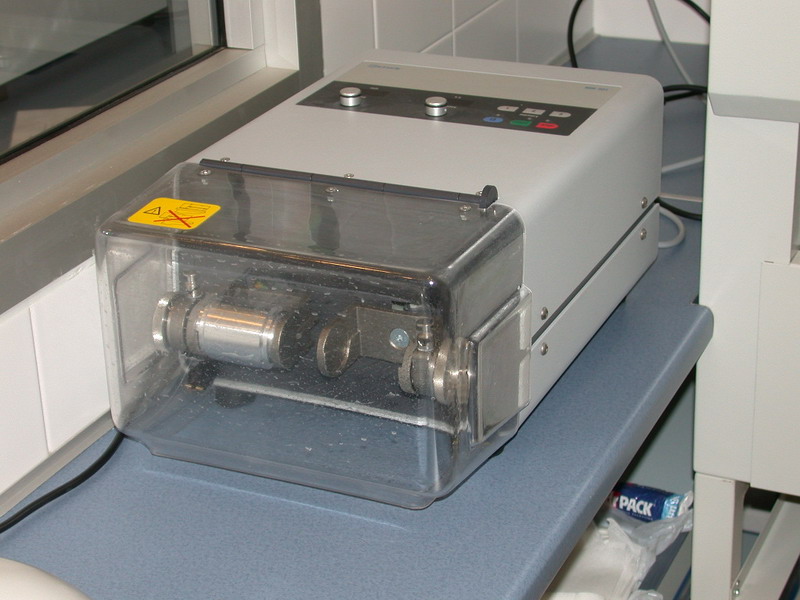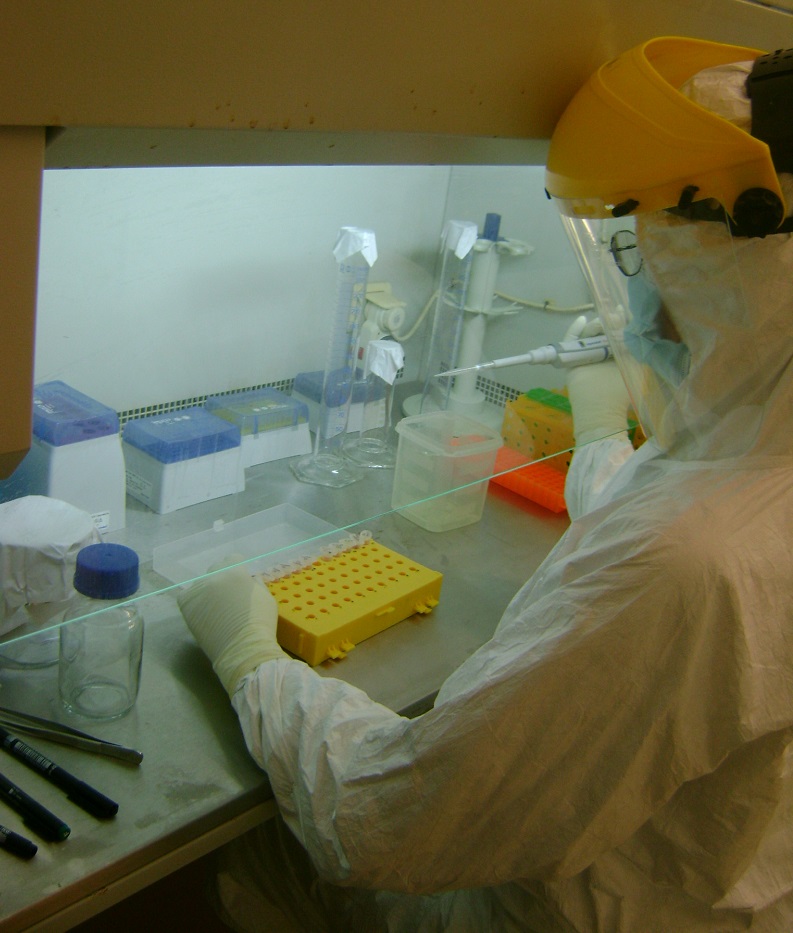 Upon entering our clean pre-PCR laboratory, each bone sample receives a unique identifier, is registered, and photographed. A special isolated cabin is used for the primary mechanical cleaning of the bones. The entire cabin is regularly bleached and exposed to UV-C irradiation before and after the scrapings. The samples are also exposed to UV-C irradiation from all sides upon entering the lab. The surfaces of the bone samples are removed using a polisher machine. A mobile vacuum cleaner continuously removes the bone powder by-product during polishing. Tooth samples are cleaned using UV-C irradiation and a sandblaster machine. The cleaned samples, which have been subsequently irradiated with UV-C, are placed into sterile bags until further analyses.
Upon entering our clean pre-PCR laboratory, each bone sample receives a unique identifier, is registered, and photographed. A special isolated cabin is used for the primary mechanical cleaning of the bones. The entire cabin is regularly bleached and exposed to UV-C irradiation before and after the scrapings. The samples are also exposed to UV-C irradiation from all sides upon entering the lab. The surfaces of the bone samples are removed using a polisher machine. A mobile vacuum cleaner continuously removes the bone powder by-product during polishing. Tooth samples are cleaned using UV-C irradiation and a sandblaster machine. The cleaned samples, which have been subsequently irradiated with UV-C, are placed into sterile bags until further analyses.
The samples are ground into a fine powder using a mixer mill (Retsch), crushing in ball milling mills, or by drilling bone powder. The resulting powder is measured in a sterile box and then stored in sterile tubes at 4°C until use. Each batch of samples has a negative control taken from the milling and later from the DNA extraction. The negative controls are processed parallel with the bone samples.
The DNA extraction takes place in clean laboratory conditions, under a laminar flow box in a separate room. Several extraction methods are applied depending on the state of the sample and the purpose of the analysis. The DNA extraction workflow has been automated in Biomek workstations, making it easier and faster to process samples. The DNA extracts, marked by specific ID numbers, are stored in the freezer. Each series uses separate isolation negative controls, which are also treated in parallel with the sample. This contains only the solutions used in the purification process.
From DNA extractions, DNA libraries are prepared manually or using robotic technology. During DNA library preparation, DNA is chemically repaired, and samples are barcoded with individual adapters. After amplification, the samples are prepared for next-generation sequencing (NGS), which is performed in-house using the Illumina MiSeq Platform. Depending on our research objectives, DNA regions are selected (whole mitochondrial genome, single nucleotide polymorphisms) from the samples using the method of target capture, or random “shutgun” sequencing is performed.
Autosomal DNA
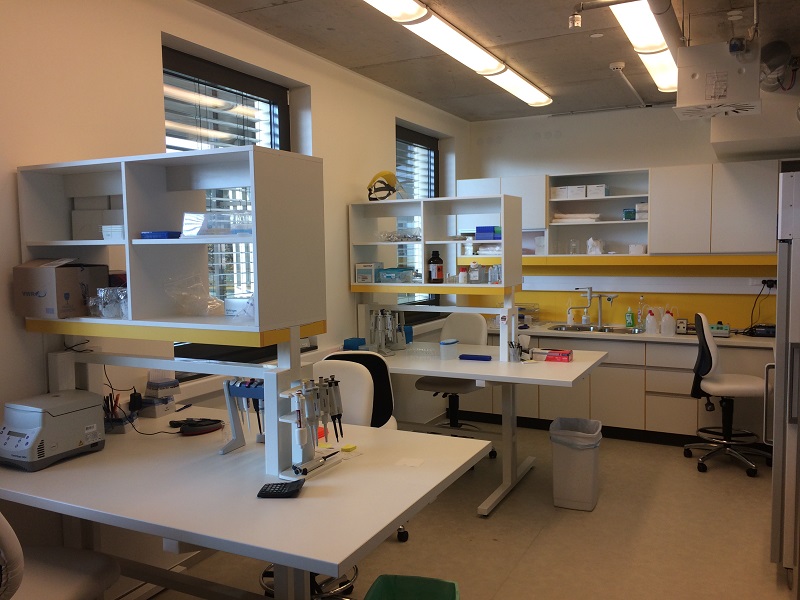 In diploid human cells, autosomes consist of 22 pairs of chromosomes, each containing two variants of an allele or marker. These markers are present in diploid form, meaning there are maternal and paternal pairs; however, they may carry different alleles and variants of the same gene. Autosomal DNA examination is suitable for determining familial relationships through bloodlines. The likelihood of establishing a direct familial relationship increases with the number of markers tested and the size of the sections examined. The autosomes are commonly used in forensic science for the identification and assignment of skeletal elements in disturbed burial sites, reconstruction of historic genealogies, and families.
In diploid human cells, autosomes consist of 22 pairs of chromosomes, each containing two variants of an allele or marker. These markers are present in diploid form, meaning there are maternal and paternal pairs; however, they may carry different alleles and variants of the same gene. Autosomal DNA examination is suitable for determining familial relationships through bloodlines. The likelihood of establishing a direct familial relationship increases with the number of markers tested and the size of the sections examined. The autosomes are commonly used in forensic science for the identification and assignment of skeletal elements in disturbed burial sites, reconstruction of historic genealogies, and families.
Nuclear DNA is typed on the Illumina platform. Besides ready-to-use commercial kits, we have been developing in-house protocols for Next-Generation Sequencing (NGS) analyses, specifically targeting forensically and population genetically relevant markers. Additionally, we perform shotgun sequencing on the indexed DNA libraries.
The results are evaluated by programs and bioinformatics tools which are used by international laboratories. Link: Software | David Reich Lab (harvard.edu). Following publication, raw and evaluated DNA data become available in international online databases (ENA, NCBI) and as online supplementary materials accompanying the publications.
Y-chromosome DNA
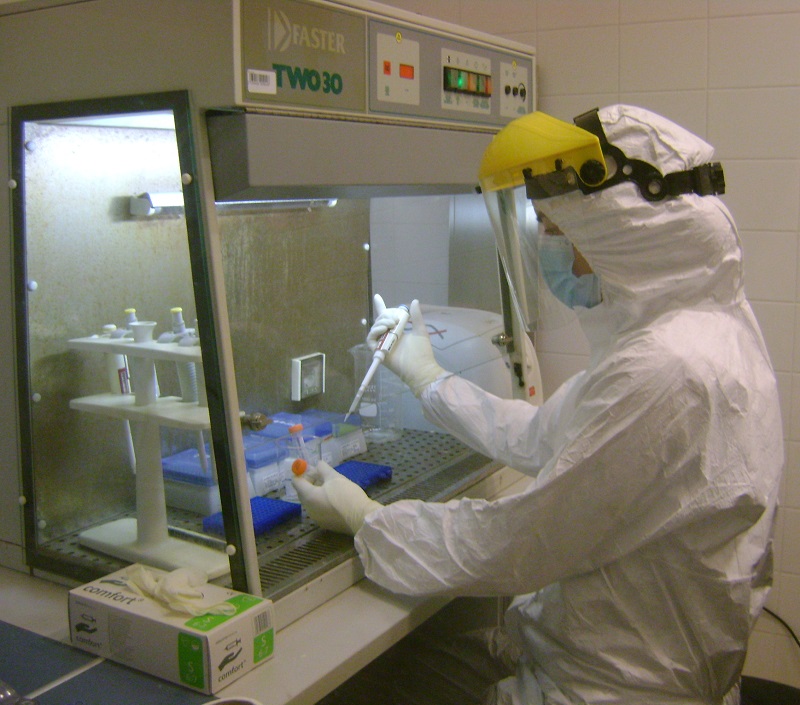 In addition to autosomes, the nuclear genome also contains sex chromosomes (X and Y). The Y-chromosome is inherited through the paternal lineage and has relatively few coding regions and a high mutation rate. Most part of it (95%, a 24 Megabase pair long section) undergo recombination with the X-chromosome. Analyzing its markers enables the tracing of paternal lineages and past male-specific population genetic events. The multiplex analysis techniques of Y chromosomal SNPs (single nucleotide polymorphisms) and STRs (short tandem repeats) play significant roles in our studies. Since 2015, we have also employed next-generation sequencing techniques in these analyses.
In addition to autosomes, the nuclear genome also contains sex chromosomes (X and Y). The Y-chromosome is inherited through the paternal lineage and has relatively few coding regions and a high mutation rate. Most part of it (95%, a 24 Megabase pair long section) undergo recombination with the X-chromosome. Analyzing its markers enables the tracing of paternal lineages and past male-specific population genetic events. The multiplex analysis techniques of Y chromosomal SNPs (single nucleotide polymorphisms) and STRs (short tandem repeats) play significant roles in our studies. Since 2015, we have also employed next-generation sequencing techniques in these analyses.
Analysis of mitochondrial DNA (mtDNA)
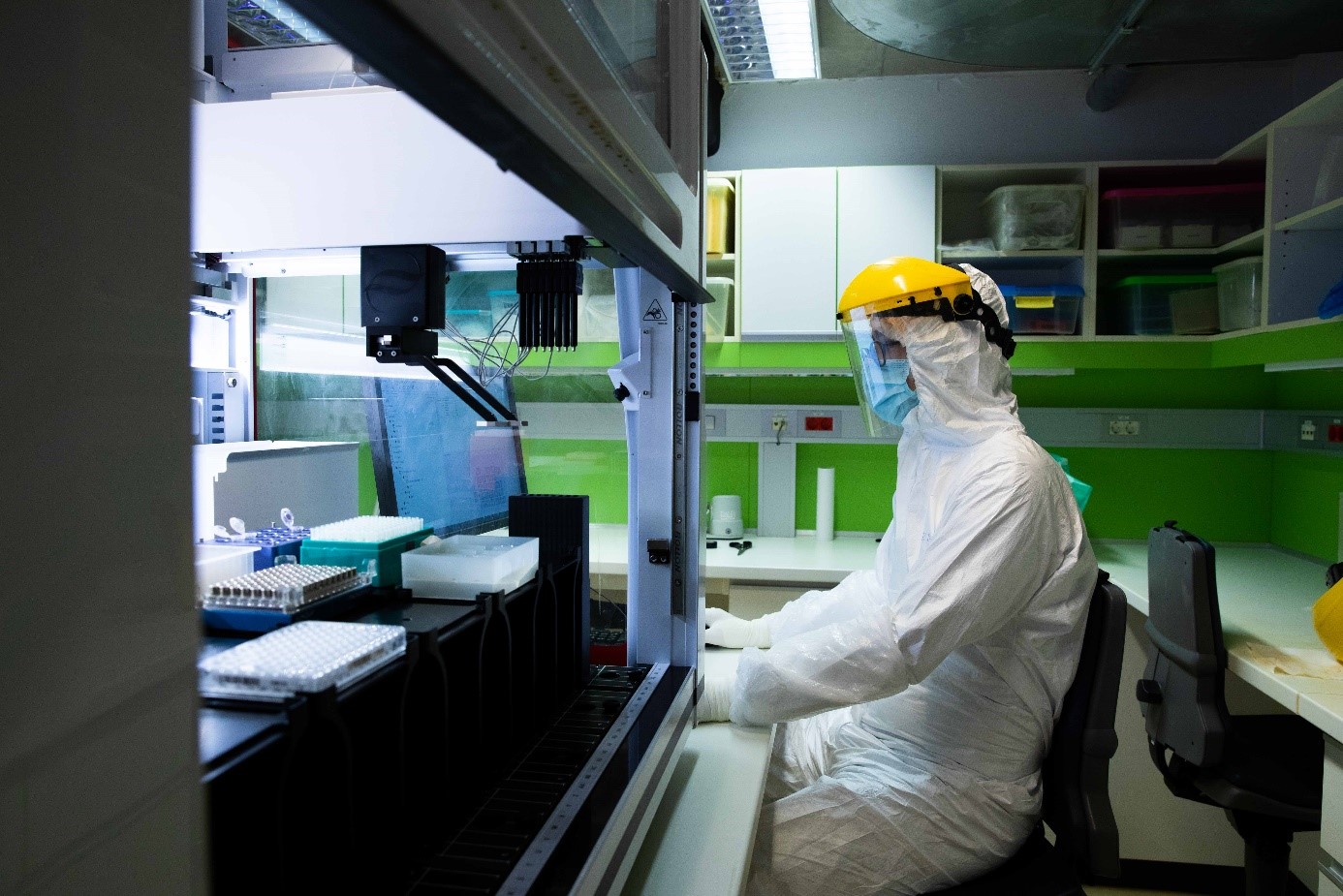 The mitochondria generate the cell's supply of adenosine triphosphate (ATP), which serves as a source of chemical energy. Mitochondria have their own genome (mtDNA) with a circular configuration. In contrast to nuclear chromosomal DNA, which is present in each somatic cell as a double set, mtDNA exists only as a single copy. It is primarily inherited through the maternal lineage because female mitochondria predominantly contribute to the newly developing individual's genetic makeup, and all members of a maternal lineage share the same mtDNA ancestry. Since several hundred mitochondria are found in a single cell, their DNA markers can provide valuable information on maternal relationships, population genetics, and population history. Our primary focus was on the Hypervariable Region I (HVR-I) of the mitochondrial genome, which is the most relevant and well-studied part of mtDNA in population genetic studies. We complemented this analysis by typing several polymorphisms in the coding region of mtDNA to validate our data and confirm certain haplogroup classifications. Since 2015, PCR-based methods have gradually been replaced by whole mitochondrial genome sequencing using target capture protocols and the Illumina MiSeq sequencer. DNA library preparation and capture protocols have also been optimized for the Biomek i5 robot, thereby increasing the laboratory's sample processing capacity.
The mitochondria generate the cell's supply of adenosine triphosphate (ATP), which serves as a source of chemical energy. Mitochondria have their own genome (mtDNA) with a circular configuration. In contrast to nuclear chromosomal DNA, which is present in each somatic cell as a double set, mtDNA exists only as a single copy. It is primarily inherited through the maternal lineage because female mitochondria predominantly contribute to the newly developing individual's genetic makeup, and all members of a maternal lineage share the same mtDNA ancestry. Since several hundred mitochondria are found in a single cell, their DNA markers can provide valuable information on maternal relationships, population genetics, and population history. Our primary focus was on the Hypervariable Region I (HVR-I) of the mitochondrial genome, which is the most relevant and well-studied part of mtDNA in population genetic studies. We complemented this analysis by typing several polymorphisms in the coding region of mtDNA to validate our data and confirm certain haplogroup classifications. Since 2015, PCR-based methods have gradually been replaced by whole mitochondrial genome sequencing using target capture protocols and the Illumina MiSeq sequencer. DNA library preparation and capture protocols have also been optimized for the Biomek i5 robot, thereby increasing the laboratory's sample processing capacity.



